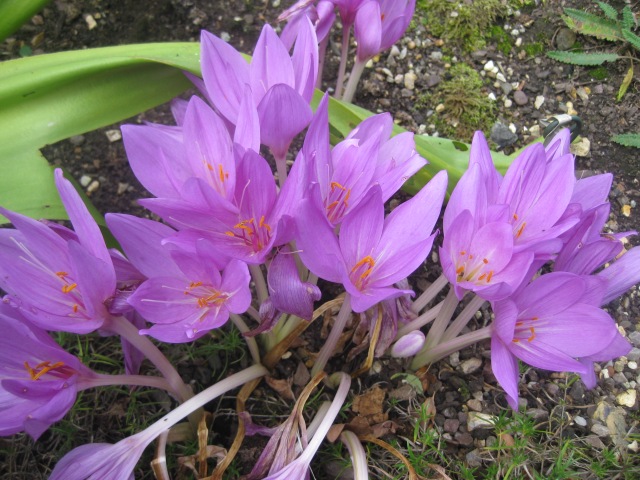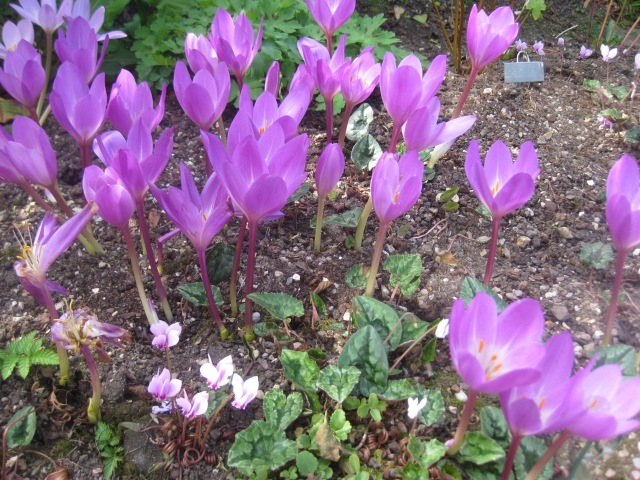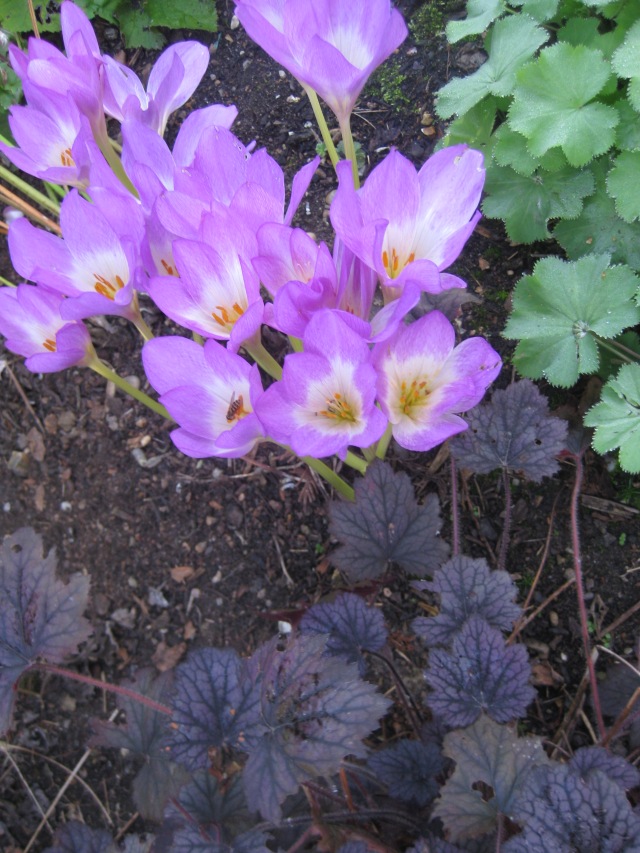I was going to call this post ‘Naked Ladies’, but then decided that it would attract the wrong sort of reader. But this is in fact the common name for these beauties because the flowers appear without any foliage.

Colchicums are commonly mistaken for autumn crocuses (or should it be croci?) But there is a difference if you look at the flowers closely. Crocuses have three stamens and colchicums have six. Some people prefer crocuses because they are more delicate, but I love colchicums; they give the garden a much needed blast of colour in early autumn.
The first one to flower always gives me a shock by appearing in August. It is Colchicum autumnale which seems rather a misnomer, as by the autumn it has been and gone.
It is the only colchicum which is native to the UK and used to flourish in the west of the country, but I believe it is rare now. Gerard writes that it is good as a remedy for gout. He says it comes from the Isle of Colchis. In fact what was known as the ancient city of Colchis is in the Black Sea area of Georgia. If you remember your Greek mythology, you will recall that Colchis was the destination of Jason and the Argonauts in the quest for the Golden Fleece. Colchicums were said to have sprung up from drops of the poisonous potion brewed by Medea, the daughter of the King of Colchis. In fact she intended it as a love potion, but colchicums are very poisonous.
It would seem that Gerard’s gout remedy is pretty deadly. There have been several recorded accidental deaths by colchicum poisoning. Apparently, people have mistaken it for wild garlic. Incredibly stupid people they must have been too. In the nineteenth century, colchicum was used by a woman called Catherine Wilson as a poison. The symptoms resembled those of cholera, so in those days, so she had a chance of getting away with it. She was a nurse and persuaded people to change their wills making her the beneficiary and then she killed them with colchicine. She is suspected of murdering her first husband and several other people. She was hanged in 1862. So don’t snack on your colchicums.
The white form Colchicum autumnale ‘Album’ is a bit later and seems to last longer in my garden.
Much bigger and showier are the lovely Colchicum speciosum hybrids. The most coveted one, Colchicum speciosum ‘Album’ was bred in the late nineteenth century by Backhouse of York. E.A.Bowles tells us that when he first saw it, there were only three bulbs in existence and even years later they changed hands: ‘at a price only suitable for millionaires’. It is indeed a gorgeous bulb with huge goblets of glistening white.
Another of the Backhouse hybrids is a favourite of mine. It is Colchicum speciosum ‘Atrorubens’. I love the way that it is purple all down the stem.
I have clumps of colchicums scattered all round the garden and I have decided that unless you can afford hundreds of bulbs this is not a great way to display them because they just don’t have enough impact. I was at Beth Chatto’s garden recently and she has them threaded throughout the garden, particularly in the woodland garden. They looked lovely, but the cost of doing this would be prohibitive for most of us.
I also saw them growing in a special bed on a recent visit to East Ruston Vicarage garden. I love this garden and I have been meaning to write about about it for a while now, but I keep getting side-tracked. I will try to make it my next post. But I am not keen on this way of displaying colchicums in all their nudity. And I think the labels are intrusive.

Last week, I visited the wonderful garden of the bulb specialist, Rod Leeds who lives near me. He wrote the three books which are my bulb bibles. ‘Autumn Bulbs’, ‘The Plantfinder’s Guide to Early Bulbs’ and ‘Bulbs in Containers’. Not only does he have varieties of colchicums that I have never seen before, but the display in a bed alongside his drive made a big impact. It inspired me to write this post and to contemplate making an autumn bed of colchicums myself. I am not sure where yet; I can’t quite face digging up more lawn. But I am definitely going to dig up all my colchicums and place them in a bed together. As they are so naked when they flower, I loved the way Rod gave them frills of the parsley fresh Polypodium cambricum ‘Richard Kayse’.
I found a nursery on line which stocks this gorgeous fern and I bought it along with a Polypodium cambrian ‘Pulcherrimum Addison’ which is one Bob Brown of Cotswold Garden Plants recommends.
The problem with colchicums is the fact that in spring, they have the most enormous leaves which can be a nuisance, and they don’t die back prettily. I might borrow some of Beth Chatto’s ideas for companion plants. The white spotted pulmonaria foliage is perfect with the gorgeous flowers of Colchicum speciosum ‘Album’
Lamium maculatum ‘White Nancy’ can be invasive, but it too looks good with the white colchicum. The native fern Asplenium scolopendrium crops up all over my garden and how nice it looks in this group.
Whoops, this next one is a combination I will not be copying . Ground Elder is the bane of my life. I spend my life trying unsuccessfully to eradicate it. Even if this is the variegated form, it is not welcome in my garden. The double Colchicum ‘Water Lily’ is not one of my favourites. Almost as soon as it blooms it collapses untidily.
I don’t think I would use the invasive periwinkle either.

So what would I use? I already have plum-coloured heucheras planted with some of them and they look good together. The foliage of Alchemilla mollis sets them off well too, as long as you keep it neatly trimmed.
I may also plant a few autumn flowering Liriope muscari with them.
And in a sunny spot what about some lovely yellow Sternbergia lutea? Although I must admit that so far I have not had much success at getting them to bloom every year. These are in Rod’s garden.
I shall certainly borrow Rod’s idea of planting Cyclamen hederifolium along the front of the bed. I think this bed is going to be great fun to make and it will be a chance to acquire some different colchicums. By the way, if you want to move colchicums, the best time to do it is after the leaves die down and they have gone dormant.


















Those are such pretty flowers. I like your combinations.
The combinations are in Beth Chatto’ s famous garden. But I am going to copy some of them.
Thanks for your information about when to move Colchicums, I obviously moved some of mine at the wrong time of year and lost them! They are lovely flowers at this time of year, so I must buy some more varieties, and I agree, they look so much better growing through some ground cover. I’m looking forward to seeing your new Colchicum bed, it will be gorgeous!
Thank you Pauline. You would think that they would move alright after blooming but I suppose the roots are growing strongly at this time of the year.
I have chosen a good site for my new colchicum bed but it needs a lot of work doing on it first, it’ s one of the messy areas that I don’ t usually show on this blog. The colchicums have inspired me to tackle it.
What a wealth of information and entertainment you provide, thank you. I think the pale pink-purple ones we inherited must have had their leaves mowed off in the first spring. There were only one or two sad flowers later that year. Oops. Your lovely post encourages me to plant some more in their place. The sought after white ones look enticing ….
Thank you Kate. Yes the huge leaves are a big drawback and like all bulbs they are necessary to build up reserves for the plant. If it wasn’ t for this they would be great planted in grass.
The Colchicums are very pretty but I also think they look best growing through something to gird their loins. The bulbs aren’t often seen here – when they are, they’re usually offered as novelty items rather than sold for mass planting. We do have our own naked ladies though, in the form of Amaryllis belladonna. Unfortunately, mine didn’t make an appearance this year, possibly because their foliage was burnt to a crisp by an early heatwave.
Amaryllis belladonna only survive if they can bake in the sun and have the protection of a wall. I did have some once but they didn’ t survive. How lovely to be able to grow them.
I agree colchicums need a bit of a skirt to hide their nakedness.
So petty! 🙂
They are a delight and such a welcome sight in early autumn.
True! I recently visited Toronto Botanical Garden and saw quite a few groups of them blooming! 🙂
A thought provoking post, we don’t have any in our garden. I always thought they were a waste of garden space due to them being knocked flat by autumn rain. Perhaps I should try some in pots?
There are more than 60 species so you should be able to find something for a pot. Hybrids such as Colchicum byzantinus or ‘Water Lily’ will get ruined by heavy rain but Colchicum speciosum doesn’ t.
You tell such great stories! I don’t grow these, but am tempted now. I especially love the combination of Colchicum speciosum ‘Album’ with Pulmonaria. Truly winsome.
Oh thank you Allison. I like a story. Colchicum speciosum ‘ Album’ is a real aristocrat. Bowles waxed lyrical about it and rightly so I think.
I’m still not sure about Colchicums, I am experimenting but so far I’m not convinced. I like your idea of an autumn border with companion plantingbut wonder whether the big leaves of the Colchicums would swamp the companion plants or whether the companion plants would restrict the ability of the Colchiums to feed the bulbs. I suppose there is only one way to find out.
Sternbergias, I’m a big fan and the secret of getting them to flower is a good summer baking. I flowered them out doors in Worcestershire on a regular basis, so climate wise you should be OK.
Beth Chatto grows them through mats of periwinkles and ivy and they do fine. Rod Leeds is the expert and his look fine with companion planting. I will go and see what they look like in spring and summer. The big leaves are a drawback, but they have gone by summer.
An interesting post with good pictures about a lovely flower, albeit one that I’ve rarely see outside of gardens like Beth Chatto’s. If I had a garden they would certainly feature in it as a welcome touch of colour for this time of year. xx
They are a real bonus at this time of the year. They mind their own business all summer and then brighten up the garden at the end of September.
Like croftgarden above, I’m undecided about colchicums. Whenever I’ve seen them, they look rather forlorn and tatty, so not worth the bother. But your photos and combinations do look pretty, especially the heuchera/alchemilla combo. I look forward to seeing how you display them next year 🙂
I don’ t think Colchicum speciosum ever looks tatty although some of the other hybrids can look a bit dishevelled. Next year, I will try and convince you.
Thanks Chloris, your dedication and eye for detail is inspirational. I tried the water lily Colchicum amongst Arum italicum marmoratum and they looked lovely for the first year. Thereafter, the Arums ate the crocus, undeterred by poison or good manners.
I had thought of planting them with Arum italicum, I never guessed that would happen. How odd. You’ d think it would be the other way round. The colchicums are bigger and more poisonous.
Down to my severely sandy soil, I suspect. A. italicum is a relative of A. maculatum, cuckoo pint. The pint part comes from pintle, the old English for penis, referring to the pollen bearing spathe. So the boys toughed it out, where the naked ladies took the vapours and passed away. If you are suitably ruthless in limiting the spread of the arum, with your fabulous collection of Colchicums it would look breath-taking.
Goodness, in that case, I don’ t know whether I could put these two in a bed together. Decency and decorum are what we strive for here. I have enough problems with my wild eyed scarecrow with her padded bra and platinum blonde wig shocking the neighbours. Not to mention my Dracunculus vulgaris which is very vulgar indeed.
Sorry, decorum is out of the window here, in the pursuit of cheap laughs. I have an Amorphophallus konjac (related to Attenborough’s titan arum) in the conservatory, with which I hope to startle everyone. Awaiting my first bloom with interest.
I’ve got those two ferns, and the periwinkle, and they are looking a bit boring at the moment. It would be so easy to add those colchicums. So much of gardening is hard graft, it’s nice when you can just add a little something and lift an area for not too much effort. I have always loved those white colchicums but couldn’t think where to put them. I have rivers of the white pulmonaria all through my borders, so could add some in there as well. I think the bed in the Norfolk garden is a good way to see new varieties and compare them side by side. Even though I wouldn’t want to copy this idea. It’s good for a garden open to the public, as an education. Thanks for sharing your photos and for the inspiration.
I love these ferns, they are so fresh looking at this time of the year. Well you have the ideal places for some lovely Colchicum speciosum.’ Album’.
Are there shorter varieties which don’t flop? The fact of them being poisonous might work in their favour for me. Fear not, it’s only the slugs I want to bump off.
Specoisum is a taller variety, but it only flops when the flower is finished. Look at the photos, the speciosum are all standing up beautifully.’ Water Lily’ is a great flopper.
The good news is that deer and rabbits don’ t touch them. The bad news is that molluscs will chew them sometimes.
So many beautiful varieties of colchicum!
There are more than 60 species, so plenty to choose from. My favourites are the speciosum hybrids because they are big and showy and don’ t flop.
Wow,fantastic, I think this is used for gout, which runs in my family.. However, I won’t be making tea anytime soon.
See if you can find Big Blue Liriope muscari, I think it would look wonderful with the bulbs.
Oh no, please don’ t try it as a gout remedy.
I have Liriop muscari and it is very pretty at this time of the year but I haven’ t come across ‘ Big Blue’. I have a pretty one with variegated leaves too.
Colchicum (or colchicine) is still an excellent and very commonly used remedy for gout. It is especially used in patients who cannot take anti-inflammatories. But yes, very poisonous in large doses. We only give out 12 tablets at a time.
The white ‘Album’ is my favourite, but I am a sucker for white flowers of any kind. And now as I am writing ‘white album’… I wonder if the Beatles realised they were punning there…
Amazing that one of Gerard’ s remedies is still used today. I should imagine the dosage wss a bit hit and miss in those days.
I don’ t suppose the Beatles had heard of Colchicum speciosum ‘ Album’. It is a gorgeous plant. Still quite expensive.
Those are pretty flowers, Chloris. I’ve never tried them, but I bet they are hardy here in S. Ontario.
And now I know that what we call bishop’s weed or gout weed is what you call ground elder. What a terrible thug it is!
I read this somewhere recently and thought: 2 1/2 feet? “I was able to eradicate a small area of my vegetable garden by digging down 2 1/2 feet, removing all the roots of goutweed (as well as the plants) and allow the area to sit fallow for 6 months covered with black plastic. After six months I brought in new soil and re-planted. After 2 years there has been no return of goutweed.”
I wonder why it’ s called Bishop’ s Weed. Devil’ s Weed would be more appropriate. I have tried covering it in cardboard but it soon grows back stronger than ever. Black plastic is worth a try, but I have it all over the place. I have even tried weedkiller which I hate using. It laughs in the face of weedkiller and treats it like a tonic.
Your first line made me smile but your last line made me laugh. Right on!
very interesting. I have some but the spring leaves are an issue. However, I do have a woodland area where they might work. Do you think dry shade would be a problem?
I agree, the leaves are too big to disguise. I believe they don’ t flower so freely in shade.
They are wonderful – thanks for sharing.
They are lovely, do you have any?
How lovely they all are, I especially like the white ones. I haven’t a single one! Must do something about that! I did like all the combinations, it will be interesting to see what you finally go with. I enjoyed the stories and legends too, I shall certainly avoid them medicinally!xxx
Yes, the white is my favourite. It is worth getting a few, they are a delight in early autumn.
I love the back story to colchicums (and Bodger’s comments above), although I already knew that they were poisonous. I’m also on the fence about colchicums as they always seem a bit bruised and battered by the weather but I’m sorely tempted by C. autumnale ‘Album’, also by that Polypodium! I’m considering plants for a shady corner of a new space I’m planting up and, as luck would have it, Fibrex Nurseries (the fern people) will be at the RHS autumn show at the end of this month. Purses at the ready!!
Bodger always makes me laugh.
The big speciosum hybrids don’ t collapse so much.
I got my ferns from Fibrex. I do love ferns, a pity they are always so expensive.
Colchicums are favorites of mine as well and I very much enjoyed the back story. Colchicine is still used to treat gout and is very effective in the correct dosage. I was very lucky to have inherited quite a few of these with my current garden and am always on the lookout for different varieties. Beautiful!
Oh you like them too. Do you have many? I was surprised to learn that there are over 60 species.
The Colchicums are beautiful. I like how they make bright, colorful patches. Don’t have any myself just yet.
Ah well, I think you must have a few patches next year too.
These are amazing flowers. I haven’t had much (if anything) to do with them and it is so interesting reading about them. Very inspiring. 🙂
Colchicums are a delight in late summer, it’ s a pity the leaves are so big and ungainly in spring.
I’ve never grown these. I tried Saffron crocus one year, but had trouble with deer and gophers.
I had to look up gophers because I’ ve never been exactly sure what they are. Goodness, they look like a cross between a mole and a rat. And you have deer as well. You are a brave and a determined gardener to battle on with wildlife like this.